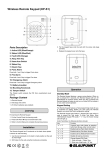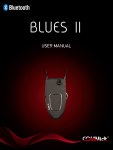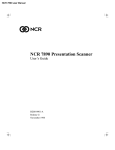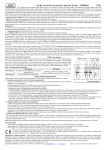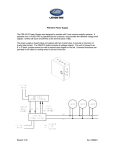Download IR-S1 User Manual
Transcript
Wireless PIR Motion Sensor (IR-S1) Parts Description Installation 1. Learn/Test Button & LED indicator Press the button to transmit a learn/test code and enter Test mode for 3 minutes. The LED will light up whenever a movement is detected under Test mode. The PIR Sensor has knockouts on the back where plastic is thinner. The 2 center knockouts are for flat wall mounting, and the 4 side knockouts are for corner mounting. 2. Battery Insulator 1. Break through the knockouts; use the knockouts to mark position on the wall or corner. 3. Supervision Enable/Disable Jumper Switch (JP2) 4. High/Low Sensitivity Jumper Switch (JP3) 5. Tamper Switch The Tamper switch protects the PIR from unauthorized cover opening. 2. Drill holes into the wall or corner using the knockouts as template. 3. Fix the PIR Sensor base onto the wall with the screws and plugs provided. 4. Replace the PIR Sensor cover onto the base. Package Content Corner Fixing Knockouts x 4 1 x PIR Sensor 4 x wall plugs and screws Surface Fixing Knockouts x 2 (Inside) 2 x 1.5V alkaline batteries (pre-installed) Supervision Enable/Disable Jumper Switch (JP2) Jumper On Jumper Off The jumper link is inserted connecting the two pins if the jumper link is removed or parked on one pin. If enabled, the PIR sensor will transmit supervision signal to Control Panel periodically for the sensor to monitor PIR sensor condition. Jumper set to ON = supervision function is Disabled (Default) Jumper set to OFF = supervision function is Enabled High/Low Sensitivity Jumper Switch (JP3) Jumper On Jumper Off The jumper link is inserted connecting the two pins if the jumper link is removed or parked on one pin. Jumper set to ON = PIR sensitivity is set to High Jumper set to OFF= PIR sensitivity is set to Low (Default) Learning Put the Control Panel into learning mode, then press the learn button to transmit learn code. Please refer to Control Panel manual for to complete the learning process. Operation Sleep Timer The PIR features a “sleep time” of approximately 1 minute for power conservation. After transmitting a detected movement, the PIR will not retransmit for 1 minute. Any further movement detected during this sleep period will extend the sleep time by another minute. In this way continuous movement in front of a PIR will not unduly exhaust the battery. Test Mode Press the Test Button to enter Test mode for 3 minutes. Sleep timer will be disabled under Test mode, and the LED indicator will flash every time a movement is detected. Use the Test mode to determine PIR detection coverage and plan the installation location accordingly. LED Indicator Off On (2 seconds) Normal Operation - When Tamper Switch is triggered - Movement detection under low battery, tamper triggered, or Test mode. Battery The PIR uses two alkaline 1.5 V batteries as its power source. It also features low battery detection function to notify the Control Panel when the battery voltage is low. When PIR is on low battery, follow the procedure below to change the batteries. 1. Open the PIR back cover. 2. Remove the old batteries. 3. Press the tamper switch several times to fully discharge. 4. Insert the new batteries observing correct polarity. The PIR LED will light up for 30 seconds to indicate it is warming up. 5. Replace the PIR back cover. Specification Environmental Condition -10°C to 40°C, relative humidity 85% non-condensing. Radio 433 MHz FCC Statement This device complies with Part 15 of the FCC Rules. Operation is subject to the following two conditions: (1) This device may not cause harmful interference, and (2) This device must accept any interference received, including interference that may cause undesired operation. FCC Caution: To assure continued compliance, any changes or modifications not expressly approved by the party responsible for compliance may void the user's authority to operate this equipment. (Example - use only shielded interface cables when connecting to computer or peripheral devices).


